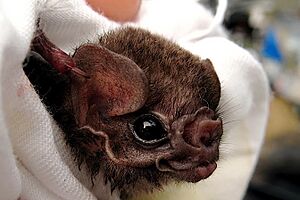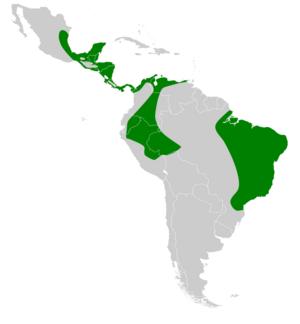Hairy-legged vampire bat facts for kids
Quick facts for kids Hairy-legged vampire bat |
|
|---|---|
 |
|
| Conservation status | |
| Scientific classification | |
| Genus: |
Diphylla
|
| Species: |
ecaudata
|
 |
|
| Range map | |
The hairy-legged vampire bat (Diphylla ecaudata) is one of three types of vampire bats. It mostly drinks the blood of wild birds. Sometimes, it also feeds on farm birds and even humans. This bat lives in warm, wet forests in South America, Central America, and southern Mexico. It is the only species in its group, called Diphylla.
Contents
About Its Name
A German biologist named Johann Baptist von Spix first described this bat in 1823. He found the species in Brazil.
Spix gave the bat its scientific name, Diphylla ecaudata. The name Diphylla means "double leaf" in Latin. The species name ecaudata means "without a tail." This is because the bat does not have a tail.
There are two recognized types, or subspecies, of this bat:
- Diphylla ecaudata centralis is found from western Panama up to Mexico. One bat was found far north in Texas in 1967, which was unusual.
- Diphylla ecaudata ecaudata is found from Brazil and eastern Peru to eastern Panama.
What It Looks Like
This bat looks similar to the common vampire bat. However, it has some key differences. It has wide, short ears and large, shiny eyes. Its thumb is short and does not have a pad.
The hairy-legged vampire bat has more teeth than the common vampire bat. It has 26 teeth, while the common vampire bat has 18. Its brain is also smaller, about two-thirds the size.
The furry membrane between its legs is narrow and very hairy. As its name suggests, it does not have a tail. The fur on its back is dark brown. The fur on its belly is lighter. Its fur is soft and long. The small leaf-like shape on its nose is much smaller than on other leaf-nosed bats.
These bats weigh about 24 to 43 grams (0.8 to 1.5 ounces). Their head and body together are about 7.5 to 9.3 centimeters (3 to 3.7 inches) long. Their forearm, which is part of their wing, is about 5 to 5.6 centimeters (2 to 2.2 inches) long.
Unlike some other vampire bats, it does not have grooves under its tongue. However, it has a groove on the roof of its mouth. This groove might help guide the blood it drinks.
Life Cycle and Behavior
Hairy-legged vampire bats can have babies throughout the year. There is no specific breeding season. Females can become pregnant when they are about one year old.
Pregnancy lasts about 5.5 months, which is quite long for a small bat. Females usually give birth to only one baby, called a pup. Pups are born with their eyes open. They also have a set of baby teeth. These baby teeth are fewer than their adult teeth.
If a mother bat loses her pup, she might still produce milk. Female bats have been seen nursing pups that are not their own. Pups learn to fly when they are about 57 days old. However, they continue to nurse and get regurgitated blood from their mothers for much longer, up to about 223 days old.
These bats are active at night. During the day, they rest in sheltered places. They prefer caves and old mines. They might also use hollow trees. They usually live alone. However, they can be found in small groups of up to twelve bats. Some groups have been reported with as many as 50 bats. They sometimes share their roosts with common vampire bats and other leaf-nosed bats.
What They Eat
The hairy-legged vampire bat drinks the blood of other animals. It was once thought that they only fed on birds. However, it has now been shown that they also feed on the blood of mammals. This includes humans and cattle.
Because they can feed on mammals, it is now possible that they could carry and spread rabies. This is similar to how the common vampire bat can transmit rabies when feeding on cattle. These bats also share their food with others. They do this by regurgitating blood mouth-to-mouth.
Where They Live
This bat lives across a large area in Central and South America. They have been found in Belize, Bolivia, Brazil, Colombia, Costa Rica, Ecuador, El Salvador, Guatemala, Honduras, Mexico, Nicaragua, Panama, Peru, and Venezuela.
One bat was once found in southern Texas in the United States. This female bat was found in an abandoned railroad tunnel in 1967. This location was about 700 kilometers (435 miles) north of where the species was previously known to live. These bats can live at different heights, from sea level up to about 1,900 meters (6,200 feet).
Conservation Status
The IUCN currently lists the hairy-legged vampire bat as a least-concern species. This is the lowest conservation priority. This means their population is stable. They also live in a wide range of places and can adapt to different habitats.
These bats can be kept in captivity. They are usually given access to live hens for feeding.
See also
- Common vampire bat—one of the two other types of vampire bat
- White-winged vampire bat—one of the two other types of vampire bat


